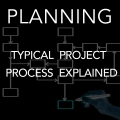For the last 2 weeks we have had a year-ten work experience student in our office. Although there is little business benefit in this arrangement, it is vitally important that secondary students who are considering a career in architecture have as much insight as possible into what it is that an architect does. This experience has included attending meetings, drawing and analysing plans, assessing site conditions and even attending the recent exhibition, Rome: Piranesi’s Vision, at the State library.
Early in the week, our enthusiastic student brought up the topic of how one becomes an architect. We explained the long process of 5 – 6 years at university and the four university options available to study Architecture in Victoria. Upon completion of university this is followed by a period of around 2 – 5 years working under a registered architect before sitting a three stage examination process in order to become a registered architect. This lengthy process is an indication of the amount of knowledge and level of skill required and expected of an architect.
Recounting this process to a year 10 student brought to mind the serious challenge confronting the architecture profession regarding the education of our profession. In May this year the Australian Federal Government revealed its budget plans to the nation. Quite shockingly, this single piece of fiscal policy will have massive detrimental consequences to a wide range of professions, industries community groups and individuals throughout society. One of these casualties is the architecture profession.
In the early 2000’s studying a six year double degree of Architecture and Construction Management at Deakin University cost approximately $36,000. For most students, these fees where under the HELP arrangement whereby the fees could be paid back over time when one earns over a minimum threshold. Crucially the amount owed would only rise in line with inflation. The 2014 proposed government changes messes with this setup in several ways.
Firstly ‘The Feds’ have substantially reduced the funding they are providing universities. To allow universities to keep paying their bills, they also propose a complete deregulation of university fees so that universities can charge whatever they like. What this means for prospective architecture students is a substantial increase in debt upon leaving university. There have been several predications regarding the likely cost of an architectural education under this new system. Some have predicted a rise to around $55,000 others are suggesting it to be closer to $75,000. The most alarming possibility was raised in the Australian Design Review. They suggested that it may come to pass that local fees may be brought into line with the newly increased international fees of approximately $150,000 to $200,000.
Whilst the $150,000 scenario might be unlikely, even the lowest predicted increase to $55,000 will be a difficult pill to swallow for prospective students. To make it even worse the Federal Government is also proposing to change how student debt is paid back. Rather than the current interest free model, the government will now be charging a variable interest rate up to 6%. This will dramatically increase the number of years the debt will take to be repaid and in many cases students will never finish paying for their degrees.
Whilst these changes will affect all university degrees, architecture will be particularly hard hit. The reason for this is firstly because the length of the university degree is a minimum of 5 years and secondly the earning capacity of an architectural graduate in the first 10 years is relatively very low (approximately $50,000 PA).
These changes are also inherently anti-family and anti-entrepreneur. This is because if you take any time out of full time employment to have children, raise a family or start a business your debt will keep skyrocketing due to the interest.
So how will this affect the architecture profession? Firstly it will reduce the diversity of new graduates as only those from wealthy families will be able to afford it. This is something the profession can ill afford if it wants to remain relevant to a diverse society. The changes will also discourage the best talent from pursuing architecture as a career.
If the extreme case does eventuate and persist I could see a future where architects no longer go to university. The option already does exist for an individual to sit an exam to determine if their skills and knowledge are equivalent to that of a graduate of architecture. To be eligible to sit this test one would need to have substantial skills and knowledge gained from a period of seven to ten years working for a registered architect. Theoretically this path to Architectural registration will only take an additional 2-5 years on the traditional university approach. Given that the university education option will come with a lifetime of higher taxes it might come to pass that individuals shun university for an industry based internship education.
An internship based education is likely to be highly practical in its approach and well suited to the job of being an architect. However I fear that in many ways this will be ultimately inferior to a broad based and carefully curated university education. Rather than fostering an appreciation of architectural history, design theory and materials science the internship is likely to focus too heavily on practical concerns such as using computer software or planning and building regulations. Whilst these aspects are important I would argue that an architect’s greatest ability is to be able to think creatively.
It is quite amazing how the education and prevailing trajectory of a profession could be altered so substantially by a bad policy which in all likelihood does not even mention the word architecture. Is it too optimistic to think that we as a society could first determine our objectives, values and what is best practice and then determine how to fund them? The alternative is letting economic politics determine our values and objectives. This is the architectural equivalent of a hospital building a factory because it couldn’t afford an operating theatre.
Meanwhile back in the studio our bright eyed year 10 student sketches her ideas onto tracing paper. 600 Kilometres away her options for the not too distant future are being argued in Canberra. My advice to her and anyone looking to study architecture, consider your options carefully. Do your research and make your decision with your eyes open.
Architecture is for Everyone




Great summary of the changes. Considering each university currently charges within $5 of the maximum allowable HECS fee and that fee deregulation is likely to move towards a cost-recovery model (and the costs for studio based education are high), the potential for student debt to greatly exceed graduate income and rise at a higher rate than inflation is deeply disturbing. The best effort of the profession to encourage diversity are likely to be insufficient to address this.